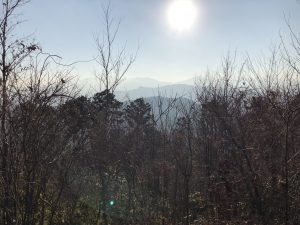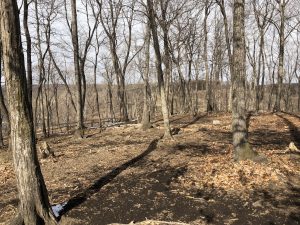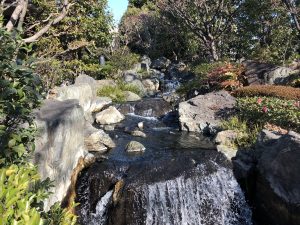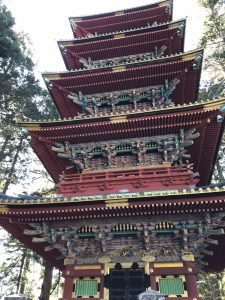Wilderness vs Satoyama: Nature in the United States and Japan
On January 19th our class made a day-trip out to Nikko National Park. It was a thought-provoking trip which succeeded in raising more questions than answers as we continue to strive for a deeper and more well-rounded understanding of nature, the environment, and sustainability in Japan. Several of our journal prompts have related to the question “what is nature in Japan?” After our trip to Nikko, I believe that I can definitively say that nature in Japan does not mean wilderness.

Now, it may seem strange that it took me a good two thirds of our journey to come to this seemingly simple conclusion. However, there is good reason that it took me so long, and it is based on assumptions on the definition of nature. In the United States, going out into nature is almost always associated, either consciously or unconsciously, with going out into nature that is “untouched” by man, left at least seemingly in its natural state. While there is still great value placed upon curated nature as found in rural communities and city parks, the idea that nature ought to be wild is one that became particularly ingrained in American culture through the influence of groups such as the transcendentalists and the Sierra Club in the mid 1800s and early 1900s. Therefore, my views of nature have been strongly influenced by men such as Henry David Thoreau who believed, “In wilderness is the preservation of the world”. Now this is only one aspect of America’s very complex and multifaceted history with nature and the environment, and it would be wrong to generalize it all as a consistent desire to preserve wilderness. However, I draw attention to this particular viewpoint because it stands in such contrast to the ancient Japanese concept of satoyama. Broadly speaking, satoyama is the idea that nature exists as a wealth of natural resources for human use and interaction. However, this interaction is not a one-way street. Humans are expected in return to cultivate, maintain, and enjoy these resources in a sustainable fashion. In the late 1900s, in response to the Japanese pollution crisis, this anthropocentric mindset was expanded upon with an emphasis on preserving a liveable and thrive-able natural environment for humans in the context of economic development.

So can these two understandings of nature be reconciled into a more comprehensive treatment of the natural environment? What can they learn from each other? In the United States, we have a fantastic system of state and national parks for the preservation of wilderness and for recreational enjoyment. However, as much as we love the ideal of preserving nature in its natural state, the reality of human dependence on our natural environment for resources cannot be ignored. As Yamakawa-san, an small-dairy farmer whose sanctuary in the forest we visited just yesterday, told us quite simply, “people must eat.” Therefore the human interface with the environment must be acknowledged and taken into consideration. With its history of satoyama, the reality of Japan’s small geographic size in proportion to population, and its considerable current percentage of imported calories, Japan makes an excellent case study of how humans have the potential to ignore or sustainably utilize the local resources surrounding us. As Yamakawa-san emphasized, the most important consideration of sustainability is whether there is the ability for a cyclical flow. In America, it is becoming more and more apparent that we cannot ignore the human impact on resource appropriation. So how can we minimize disruption to the cycle, and how can we return it to balance when we make larger disturbances? Our visit to the small dairy in the forest gave examples of both minimizing disruption (allowing the cattle to graze, therefore consuming a resource unconsumable by humans, and opening up the potential for grains that comprise usual feed to be consumed by humans instead), and returning the balance (by replanting trees that had to be felled in the cleanup following the triple disaster of 2011). While these particular techniques I have mentioned are not unique to Japan, their deep and rich roots in the concept of satoyama make Japan a valuable resource for international appreciation and application.



Similarly, Japan might be able to take away new principles from the American focus on preserving wild, natural ecosystems for their own sake. As history and Asian studies professor Simon Avenell pointed out in the intro of his book Transnational Japan in the Global Environmental Movement, Japan’s anthropocentric approach to environmental issues has tended to give it a reactive, rather than proactive or preventative, approach to environmental issues. If there were perhaps a greater focus on all the members of the ecosystem, then potential problems might be recognized before they escalate to crises. Take pollution for example. Pollution can affect human bodies indirectly and directly through a variety of routes. It may be inhaled through particulates in the air, or it may be ingested through contaminated water, produce, dairy, fish, or meat. If the ecological focus is completely on tending to natural resources for human consumption and not for its own sake, then problems may not be noticed until they reach the human link in the ecological chain. Placing importance on complete ecosystems may have prompted Japanese scientists and politicians to take more immediate actions following the fish poisonings and crop failures that preceded recognition of the Ashio Copper Mine pollution, the approximately 500,000 chickens that died after consuming rice bran oil contaminated with polychlorinated biphenyls, or even something as seemingly simple as the increased deaths of cats that occurred from the Minimata mercury poisoning. Partially redirecting the currently rather unilateral thought process that tends to look from humans to the environment could allow Japanese environmentalists to move one more rung down the preventative chain.



Lastly, perhaps one question that will be important to both methods of thinking in years to come, is how we set apart our sacred or preserved land? In the US, is it only the wilderness that can receive a protected status? Or is even that at risk with the push for copper mining in the Boundary Waters area? In Japan, the tragic environmental destruction of the Ashio copper mine, not 14 km from the venerated land in Nikko National Park is a gut-wrenching testament to the sometimes arbitrary nature of human designated significance. Land protected for the sake of divine beings’ habitations is a much different approach to protecting land for its own sake. Both of these approaches have the potential to end up at the same endpoint of preservation and sustainable use. However, given the different philosophical starting points, it is necessary to realize that it may take different routes to get there.

If there is one thing that I have come to understand from our recent assigned readings, it is that when we make transnational connections, we may be able to share valuable experiences and knowledge that may prevent unfortunate repetition of history, and forge new bonds to address problems in a new light. Even by seeking a greater understanding of what one culture views and values as nature can set us on the path of deeper connections and more nuanced approaches to larger topics such as sustainable development.
Recent Comments